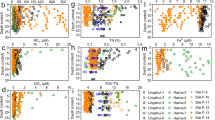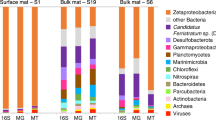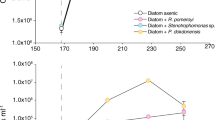Abstract
The Zetaproteobacteria are a candidate class of marine iron-oxidizing bacteria that are typically found in high iron environments such as hydrothermal vent sites. As much remains unknown about these organisms due to difficulties in cultivation, single-cell genomics was used to learn more about this elusive group at Loihi Seamount. Comparative genomics of 23 phylogenetically diverse single amplified genomes (SAGs) and two isolates indicate niche specialization among the Zetaproteobacteria may be largely due to oxygen tolerance and nitrogen transformation capabilities. Only Form II ribulose 1,5-bisphosphate carboxylase (RubisCO) genes were found in the SAGs, suggesting that some of the uncultivated Zetaproteobacteria may be adapted to low oxygen and/or high carbon dioxide concentrations. There is also genomic evidence of oxygen-tolerant cytochrome c oxidases and oxidative stress-related genes, indicating that others may be exposed to higher oxygen conditions. The Zetaproteobacteria also have the genomic potential for acquiring nitrogen from numerous sources including ammonium, nitrate, organic compounds, and nitrogen gas. Two types of molybdopterin oxidoreductase genes were found in the SAGs, indicating that those found in the isolates, thought to be involved in iron oxidation, are not consistent among all the Zetaproteobacteria. However, a novel cluster of redox-related genes was found to be conserved in 10 SAGs as well as in the isolates warranting further investigation. These results were used to isolate a novel iron-oxidizing Zetaproteobacteria. Physiological studies and genomic analysis of this isolate were able to support many of the findings from SAG analyses demonstrating the value of these data for designing future enrichment strategies.
Similar content being viewed by others

Log in or create a free account to read this content
Gain free access to this article, as well as selected content from this journal and more on nature.com
or
References
Amouric A, Brochier-Armanet C, Johnson DB, Bonnefoy V, Hallberg KB . (2011). Phylogenetic and genetic variation among Fe(II)-oxidizing acidithiobacilli supports the view that these comprise multiple species with different ferrous iron oxidation pathways. Microbiology 157: 111–122.
Badger MR, Bek EJ . (2008). Multiple Rubisco forms in proteobacteria: their functional significance in relation to CO2 acquisition by the CBB cycle. J Exp Bot 59: 1525–1541.
Berg IA . (2011). Ecological aspects of the distribution of different autotrophic CO2 fixation pathways. Appl Environ Microbiol 77: 1925–1936.
Borisov VB, Gennis RB, Hemp J, Verkhovsky MI . (2011). The cytochrome bd respiratory oxygen reductases. BBA-Bioenergetics 1807: 1398–1413.
Cabiscol E, Tamarit J, Ros J . (2010). Oxidative stress in bacteria and protein damage by reactive oxygen species. Int Microbiol 3: 3–8.
Carrondo MA . (2003). Ferritins, iron uptake and storage from the bacterioferritin viewpoint. EMBO J 22: 1959–1968.
Chan CS, Fakra SC, Emerson D, Fleming EJ, Edwards KJ . (2011). Lithotrophic iron-oxidizing bacteria produce organic stalks to control mineral growth: implications for biosignature formation. ISME J 5: 717–727.
Cox JC, Boxer DH . (1978). The purification and some properties of rusticyanin, a blue copper protein involved in iron(II) oxidation from Thiobacillus ferro-oxidans. Biochem J 174: 497–502.
Croal LR, Jiao Y, Newman DK . (2007). The fox operon from Rhodobacter strain SW2 promotes phototrophic Fe(II) oxidation in Rhodobacter capsulatus SB1003. J Bacteriol 189: 1774–1782.
Dang H, Chen R, Wang L, Shao S, Dai L, Ye Y et al. (2011). Molecular characterization of putative biocorroding microbiota with a novel niche detection of Epsilon- and Zetaproteobacteria in Pacific Ocean coastal seawaters. Environ Microbiol 13: 3059–3074.
Deutscher J, Aké FMD, Derkaoui M, Zébré AC, Cao TN, Bouraoui H et al. (2014). The bacterial phosphoenolpyruvate: carbohydrate phosphotransferase system: regulation by protein phosphorylation and phosphorylation-dependent protein–protein interactions. Microbiol Mol Biol Rev 78: 231–256.
Emerson D, Floyd MM . (2005). Enrichment and isolation of iron-oxidizing bacteria at neutral pH. Methods Enzymol 397: 112–123.
Emerson D, Moyer CL . (2010). Microbiology of seamounts: common patterns observed in community structure. Oceanography 23: 148–163.
Emerson D, Field EK, Chertkov O, Davenport KW, Goodwin L, Munk C et al. (2013). Comparative genomics of freshwater Fe-oxidizing bacteria: implications for physiology, ecology, and systematics. Front Microbiol 4: 254.
Fleming EJ, Davis RE, McAllister SM, Chan CS, Moyer CL, Tebo BM et al. (2013). Hidden in plain sight: discovery of sheath-forming, iron-oxidizing Zetaproteobacteria at Loihi Seamount, Hawaii, USA. FEMS Microbiol Ecol 85: 116–127.
Gadda G, Francis K . (2010). Nitronate monooxygenase, a model for anionic flavin semiquinone intermediates in oxidative catalysis. Arch Biochem Biophys 493: 53–61.
Garcia MO, Caplan-Auerbach J, De Carlo EH, Kurz MD, Becker N . (2006). Geology, geochemistry and earthquake history of Loihi Seamount, Hawaìi's youngest volcano. Chem Erde-Geochem 66: 81–108.
Garcia SL, McMahon KD, Martinez-Garcia M, Srivastava A, Sczyrba A, Stepanauskas R et al. (2012). Metabolic potential of a single cell belonging to one of the most abundant lineages in freshwater bacterioplankton. ISME J 7: 137–147.
Glazer BT, Rouxel OJ . (2009). Redox speciation and distribution within diverse iron-dominated microbial habitats at Loihi Seamount. Geomicrobiol J 26: 606–622.
Jiao Y, Newman DK . (2007). The pio operon is essential for phototrophic Fe(II) oxidation in Rhodopseudomonas palustris TIE-1. J Bacteriol 189: 1765–1773.
Kamke J, Sczyrba A, Ivanova N, Schwientek P, Rinke C, Mavromatis K et al. (2013). Single-cell genomics reveals complex carbohydrate degradation patterns in poribacterial symbionts of marine sponges. ISME J 7: 2287–2300.
Karl D, McMurtry G, Malahoff A, Garcia M . (1988). Loihi Seamount, Hawaii: a mid-plate volcano with a distinctive hydrothermal system. Nature 335: 532–535.
Katoh K, Misawa K, Ki Kuma, Miyata T . (2002). MAFFT: a novel method for rapid multiple sequence alignment based on fast Fourier transform. Nucleic Acids Res 30: 3059–3066.
Konstantinidis KT, Tiedje JM . (2005). Towards a genome-based taxonomy for prokaryotes. J Bacteriol 187: 6258–6264.
Konstantinidis KT, Ramette A, Tiedje JM . (2006). The bacterial species definition in the genomic era. Philos Trans Roy Soc Ser B 361: 1929–1940.
Kraft B, Strous M, Tegetmeyer HE . (2011). Microbial nitrate respiration–genes, enzymes and environmental distribution. J Biotechnol 155: 104–117.
Kumar S, Nei M, Dudley J, Tamura K . (2008). MEGA: a biologist-centric software for evolutionary analysis of DNA and protein sequences. Brief Bioinform 9: 299–306.
Lasken RS, Stockwell TB . (2007). Mechanism of chimera formation during the Multiple Displacement Amplification reaction. BMC Biotechnol 7: 19.
Ludwig W, Strunk O, Westram R, Richter L, Meier H . (2004). ARB: a software environment for sequence data. Nucleic Acids Res 32: 1363–1371.
Luque-Almagro VM, Gates AJ, Moreno-Vivián C, Ferguson SJ, Richardson DJ, Roldán M . (2011). Bacterial nitrate assimilation: gene distribution and regulation. Biochem Soc T 39: 1838–1843.
McAllister SM, Davis RE, McBeth JM, Tebo BM, Emerson D, Moyer CL . (2011). Biodiversity and emerging biogeography of the neutrophilic iron-oxidizing Zetaproteobacteria. Appl Environ Microbiol 77: 5445–5457.
McBeth JM, Little BJ, Ray RI, Farrar KM, Emerson D . (2011). Neutrophilic iron-oxidizing ‘Zetaproteobacteria’ and mild steel corrosion in nearshore marine environments. Appl Environ Microbiol 77: 1405–1412.
Moreno-Vivián C, Cabello P, Martínez-Luque M, Blasco R, Castillo F . (1999). Prokaryotic nitrate reduction: molecular properties and functional distinction among bacterial nitrate reductases. J Bacteriol 181: 6573–6584.
Pitcher RS, Watmough NJ . (2004). The bacterial cytochrome cbb3 oxidases. Biochim Biophys Acta Bioenerget 1655: 388–399.
Podar M, Eads JR, Richardson TH . (2005). Evolution of a microbial nitrilase gene family: a comparative and environmental genomics study. BMC Evol Biol 5: 42.
Pruesse E, Quast C, Knittel K, Fuchs BM, Ludwig W, Peplies J et al. (2007). SILVA: a comprehensive online resource for quality checked and aligned ribosomal RNA sequence data compatible with ARB. Nucleic Acids Res 35: 7188–7196.
Rassa AC, McAllister SM, Safran SA, Moyer CL . (2009). Zeta-proteobacteria dominate the colonization and formation of microbial mats in low-temperature hydrothermal vents at Loihi Seamount, Hawaii. Geomicrobiol J 26: 623–638.
Richter M, Rosselló-Móra R . (2009). Shifting the genomic gold standard for the prokaryotic species definition. Proc Natl Acad Sci USA 106: 19126–19131.
Rinke C, Schwientek P, Sczyrba A, Ivanova NN, Anderson IJ, Cheng J-F et al. (2013). Insights into the phylogeny and coding potential of microbial dark matter. Nature 499: 431–437.
Schloss P, Handelsman J . (2005). Introducing DOTUR, a computer program for defining operational taxonomic units and estimating species richness. Appl Environ Microbiol 71: 1501–1506.
Sedwick PN, McMurtry G, Macdougall J . (1992). Chemistry of hydrothermal solutions from Pele’s vents, Loihi Seamount, Hawaii. Geochim Cosmochim Acta 56: 3643–3667.
Shi L, Rosso KM, Clarke TA, Richardson DJ, Zachara JM, Fredrickson JK . (2012). Molecular underpinnings of Fe(III) oxide reduction by Shewanella oneidensis MR-1. Front Microbiol 3: 50.
Singer E, Emerson D, Webb EA, Barco RA, Kuenen JG, Nelson WC et al. (2011). Mariprofundus ferrooxydans PV-1 the first genome of a marine Fe(II) oxidizing Zetaproteobacterium. PLoS One 6: e25386.
Singer E, Heidelberg JF, Dhillon A, Edwards KJ . (2013). Metagenomic insights into the dominant Fe(II) oxidizing Zetaproteobacteria from Lo’ihi, Hawai’I. Front Microbiol 4: 52.
Singer SW, Chan CS, Zemla A, VerBerkmoes NC, Hwang M, Hettich RL et al. (2008). Characterization of cytochrome 579, an unusual cytochrome isolated from an iron-oxidizing microbial community. Appl Environ Microbiol 74: 4454–4462.
Staley JT . (2006). The bacterial species dilemma and the genomic–phylogenetic species concept. Philos Trans R Soc Ser B 361: 1899–1909.
Stamatakis A . (2006). RAxML-VI-HPC: maximum likelihood-based phylogenetic analyses with thousands of taxa and mixed models. Bioinformatics 22: 2688–2690.
Stepanauskas R, Sieracki ME . (2007). Matching phylogeny and metabolism in the uncultured marine bacteria, one cell at a time. Proc Natl Acad Sci USA 104: 9052–9057.
Swan BK, Martinez-Garcia M, Preston CM, Sczyrba A, Woyke T, Lamy D et al. (2011). Potential for chemolithoautotrophy among ubiquitous bacteria lineages in the dark ocean. Science 333: 1296–1300.
Swan BK, Tupper B, Sczyrba A, Lauro FM, Martinez-Garcia M, González JM et al. (2013). Prevalent genome streamlining and latitudinal divergence of planktonic bacteria in the surface ocean. Proc Natl Acad Sci USA 110: 11463–11468.
Tabita FR, Satagopan S, Hanson TE, Kreel NE, Scott SS . (2008). Distinct form I, II, III, and IV Rubisco proteins from the three kingdoms of life provide clues about Rubisco evolution and structure/function relationships. J Exp Bot 59: 1515–1524.
Thompson JD, Higgins DG, Gibson TJ . (1994). CLUSTAL W: improving the sensitivity of progressive multiple sequence alignment through sequence weighting, position-specific gap penalties and weight matrix choice. Nucleic Acids Res 22: 4673–4680.
Weber KA, Achenbach LA, Coates JD . (2006). Microorganisms pumping iron: anaerobic microbial iron oxidation and reduction. Nat Rev Microbiol 4: 752–764.
Wilkins MJ, Kennedy DW, Castelle CS, Field EK, Stepanauskas R, Fredrickson JK et al. (2014). Single-cell genomics reveal metabolic strategies for growth and survival in an oligotrophic aquifer. Microbiology 160: 362–372.
Woyke T, Xie G, Copeland A, Gonzalez JM, Han C, Kiss H et al. (2009). Assembling the marine metagenome, one cell at a time. PLoS One 4: e5299.
Woyke T, Sczyrba A, Lee J, Rinke C, Tighe D, Clingenpeel S et al. (2011). Decontamination of MDA reagents for single cell whole genome amplification. PLoS One 6: e26161.
Yoon KS, Tsukada N, Sakai Y, Ishii M, Igarashi Y, Nishihara H . (2008). Isolation and characterization of a new facultatively autotrophic hydrogen-oxidizing Betaproteobacterium, Hydrogenophaga sp. AH-24. FEMS Microbiol Lett 278: 94–100.
Acknowledgements
We thank Brian Thompson, Nicole Poulton, and Elizabeth Fergusson for their technical expertise and support in single-cell sorting and sequencing, as well as Anna Leavitt for her assistance with the physiologic studies. We also thank the captains, crew and operators of the R/V Kilo Moana, R/V Thomas N Thompson, and Jason II ROV without whom this work would not have been possible. Last, we appreciate the intellectual input provided by the members of the Single Cell Genomics Center and Geomicrobiology labs at Bigelow. This work was financially supported by the NASA EPSCoR program administered through the Maine Space Consortium Grant 10-EPSCoR-0005 and the National Science Foundation Grants OCE-0821374 and OCE-1155754. The work conducted by the US Department of Energy Joint Genome Institute is supported by the Office of Science of the US Department of Energy under Contract No. DE-AC02-05CH11231. Additional sequencing support for Bigelow Laboratory was provided through the Joint Genome Institute’s Community Sequencing Program, Project 560.
Author information
Authors and Affiliations
Corresponding author
Ethics declarations
Competing interests
The authors declare no conflict of interest.
Additional information
Supplementary Information accompanies this paper on The ISME Journal website
Supplementary information
Rights and permissions
About this article
Cite this article
Field, E., Sczyrba, A., Lyman, A. et al. Genomic insights into the uncultivated marine Zetaproteobacteria at Loihi Seamount. ISME J 9, 857–870 (2015). https://doi.org/10.1038/ismej.2014.183
Received:
Revised:
Accepted:
Published:
Issue date:
DOI: https://doi.org/10.1038/ismej.2014.183
This article is cited by
-
Aerobic and anaerobic iron oxidizers together drive denitrification and carbon cycling at marine iron-rich hydrothermal vents
The ISME Journal (2021)
-
Evidence for auxiliary anaerobic metabolism in obligately aerobic Zetaproteobacteria
The ISME Journal (2020)
-
Genomic expansion of magnetotactic bacteria reveals an early common origin of magnetotaxis with lineage-specific evolution
The ISME Journal (2018)
-
Biological rejuvenation of iron oxides in bioturbated marine sediments
The ISME Journal (2018)
-
Physiological and ecological implications of an iron- or hydrogen-oxidizing member of the Zetaproteobacteria, Ghiorsea bivora, gen. nov., sp. nov.
The ISME Journal (2017)


